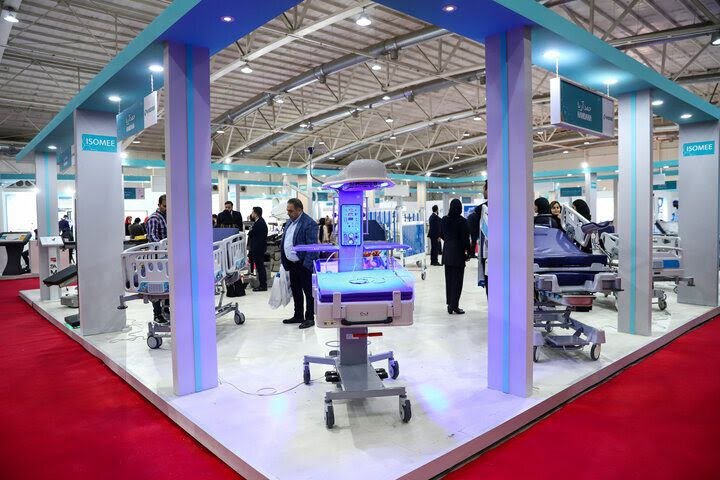Tehran – Tehran hosts the 26th International Medical, Dentistry, Pharmaceuticals and Experimental Equipment (Iran Health Expo 2025), kicks off today and ends on June 13th.
As one of the most important exhibits in the regional health sector, Iran Health Expo 2025 offers great opportunities for domestic and international companies, including countries such as China, Russia, Indonesia, the United Arab Emirates, the Czech Republic, Iraq, Afghanistan, Afghanistan, Afghanistan, Brazil, Brazil, Turkmenistan, Turkmenistan and the editors of Blazes, bringing together leading health professionals and businesses.
Approximately 600 knowledge-based companies display more than 70% of medical devices created in the country. There is an estimated 1,442 technology companies in the health sector and manufactures over 1,800 pharmaceutical tools.
Iran Health Expo is displaying the country’s latest products and achievements in the fields of biomedical engineering, pharmacology, mobile medical applications, hospital beds, respiratory medications, pediatric medical equipment, ophthalmic supplies, orthopedic equipment, pharmaceuticals, home care products, remote therapy, physiotherapy, surgical and medical emergency equipment, sonography and endoscopic, medical applications, electrical equipment, beauty products, and plastic surgery.
Iran’s health not only shares experience in health technology development, but also aims to attract foreign investment in the field of health.
Enhance the competitiveness of knowledge base and technology companies for global markets, form both domestic and foreign technology consortiums, expand the market presence, networking and sharing expertise in health technology development, commercializing the technical outcomes of the health sector, and developing national health technology are one of the main goals of the exhibition.
The exhibition also hosts a meeting of experts focusing on the role of artificial intelligence in the health sector.
Several technical tours will be held on the sidelines of the exhibition, featuring knowledge-based companies’ health-oriented products to potential clients and helping to expand the market.
Iranian Regional Leader in Health Systems
In May, the director of the World Health Organization’s (WHO) Eastern Mediterranean Regional Office (EMRO) said Iran is a major country that expands its health system and provides access to universal health insurance.
Celebrating the country’s achievements in recent years, Hanan Barki said the expansion of primary healthcare services, increased access to health insurance in rural areas, maintaining high vaccination rates, and lowering mother and newborn mortality rates, Iran can become a successful role model in the region, the health ministry’s website reported.
Officials made a statement during a meeting with Health Minister Mohammad Reza Zafarkandi. The meeting was held on the sidelines of the 78th World Health Parliament (WHA).
WHO EMRO is working closely with Iranian regulatory bodies to achieve level 3 of regulation maturity in its drug regulatory system, paving the way for wider exports of Iranian health-conscious products to the global market. It also contributes to promoting global health security, Balkhi added.
Medical self-sufficiency, medical device priorities
Issues for medical and medical device production and self-sufficiency in these regions are one of the government’s priorities, Health Minister Mohammad Reza Zafarkandi said in March.
Medicine and medical devices are two important areas related to people’s health, he said, “We are trying to reach self-sufficiency for the supply of medicine and medical devices,” the IRNA reported.
In 2024, the head of the Iranian coalition of medical device manufacturers and exporters said that about $20 million worth of medical devices are exported to more than 60 countries per year.
The IRNA says it says more than 70% of medical devices and more than 100% of regular hospital beds are made in the country.
He added that more than 95% of certain ICUs and CCU beds and more than 85% of operating room medical devices, such as anesthesia devices and other equipment, are manufactured using cutting-edge technology in the country.
Yaqoubzadeh continues, saying that the country’s need for medical devices is between $3 billion and $4 billion a year, of which $1 billion is imported.
Approximately 600 medical device companies operate domestically and produce about 99% of the medicines supplied to the domestic market.
Domestic medical device manufacturers produce and supply over 10,000 types of medical devices to domestic and foreign markets. Today, various experimental equipment are manufactured at much lower prices than the same foreign product.
On May 12, 2024, Ahmad Moslemi, a health ministry official, said 50% of medical devices are domestically produced, and Iran holds the first position in West Asia to produce medical devices in both volume and diversity, with approximately $50 million worth of medical devices created in Iran being exported to 40 countries each year.
Additionally, officials said the number of products has increased four times. Equipment such as implants and advanced medical devices are also manufactured in Japan.
Additionally, the national medical centre is equipped with around 15,000 new hospital beds, adding 90% of the locally produced equipment.
mt/mg

